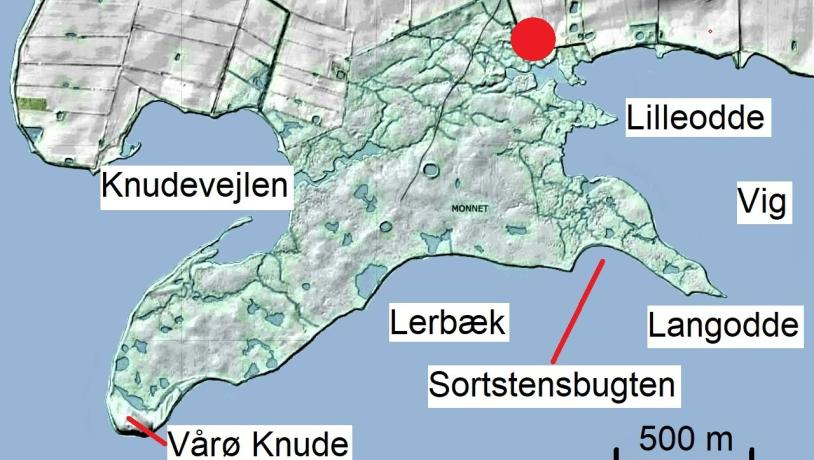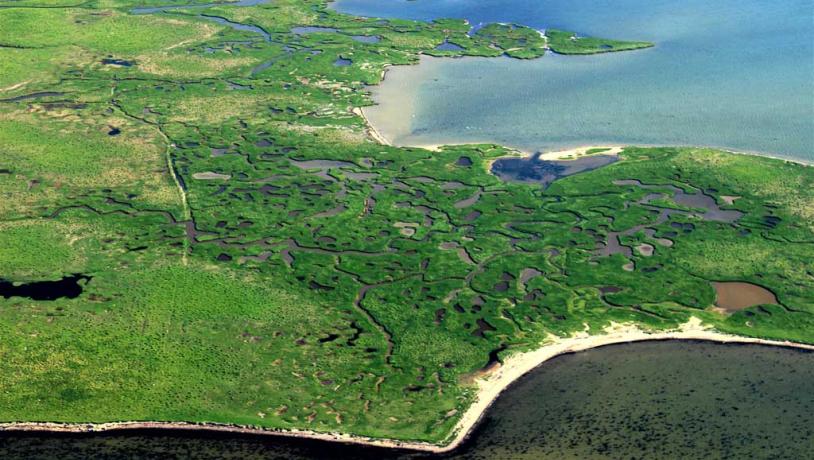Monnet
Holocene marine foreland with salt marshes, exciting birdlife and a lovely 2 km hike to the former island, Vårø Knude.
At just over 1.2 km2, Monnet is the largest salt marsh in the geopark. The desolate and peculiar landscape on the south coast of Tåsinge was protected in 1983 and is known for its exciting flora and rich birdlife.
Monnet is closed to visitors during the bird breeding period from March 15 to July 1. The rest of the year, access is on foot. The bird tower on the northeastern edge can be visited all year round and dogs are welcome on a leash. On Monnet itself, dogs are not allowed, even on a leash. There is no actual parking lot, so visitors by car must park along Monnetvej.
Monnet is an ancient cultural landscape and the salt marshes have never been drained or plowed. For centuries, the area has been used for communal grazing by the farms in Vårø Bylaug, which also owns the area. The milkmaids must have had a hard time when carrying the buckets around when milking the cows. Today, cows, sheep and horses graze the land as part of the nature management necessary to preserve the unique flora and fauna.
A beautiful stone dike that once divided Monnet into an inner and outer part was partially demolished in 1960 and sold as building material for the Siø dam.
You can hike the two kilometers across the meadows to the lonely moraine hill Vårø Knude, which overlooks the archipelago. There are traces of settlements, fields and a possible military entrenchment from the 1860s, as well as Stone Age artifacts and fireplaces.
As Vårø Knude is far enough away from everything, it was also used as a place of trial. In 1754, the daughter of Rasmus Skomager was hanged for giving birth in secret. Next to Vårø Knude are some large stones called Brændevinsstenene. They were used as a landing bridge when smuggling brandy to Ærø.

Photo:Kort: GeoFyn. Illustration: Søren Skibsted.
The ice age landscape on Monnet
The ice age landscape on the southernmost part of Tåsinge consists of a low-lying, even moraine surface. Both the landscape and the surface layers of moraine clay are attributed to the Bælthav Ice Stream, which slid up over the area from the southeast 17-18,000 years ago.
At the far end of Monnet, the flat-topped, 8-meter-high Vårø Knude is a small promontory. The hill has an elongated shape in a southeast-northwest direction, reflecting the direction of movement of the last ice streams of the Weichselian ice age. Vårø Knude consists mostly of thick layers of brownish, sandy moraine clay that emerge in the 6 meter high cliff. To the east are sloping, alternating layers of moraine clay, meltwater sand and gravel.
The central part of Monnet is slightly higher than the surrounding meadows. Here, moraine clay is visible in the circular irrigation holes, showing that the 'core' of Monnet consists of deposits from the Ice Age. There are two more small moraine nodules on Monnet, but they are almost invisible in the terrain. The large rocks along the coasts have been washed free of the ice age layers by the ocean waves over time.
The dynamic coastal landscape
After the sea invaded and created the South Funen Archipelago, Vårø Knude - along with the other moraine nodules - lay like small isolated islands in the shallow water on the flooded moraine surface off the coast of Tåsinge. The sea gnawed away at Vårø Knude and the coastal currents carried loosened clay, sand and gravel into the shelter behind the small islands, where the materials were deposited and created new land - so-called marine foreland.
Between Vårø Knude and Tåsinge, enough material was deposited to allow hardy, salt- and water-tolerant plants to spread across the area. The vegetation acted like a sieve, helping to retain clay, silt, sand and organic material, and slowly the area developed into a salt marsh that eventually became dry land. Gradually, the deposits reached a height where even the less hardy plants could thrive and contribute to the further establishment of the salt marsh.
The salt marshes are regularly flooded by high tides, leaving behind fine clay particles and organic material that is deposited as silt between the plants. In this way, the salt marsh slowly grows in height. The tides also have an impact on the development. Part of the water flows back to the sea via the winding tidal channels (loes). In the summer months, seawater can sometimes be trapped in drainless depressions, whose surface is slowly covered by a white crust of salt as the seawater evaporates. They are therefore called salt pans.
On the northwestern coast of Monnet, a small odd system has developed in less than 180 years.

Photo:Søren Lisby
The landscape in the future
As a single site, Monnet differs from the other selected sites in the Geopark by consisting almost entirely of a Holocene marine foreland, where the small 'island', Vårø Knude, represents the 'drowned glacial landscape'.
Monnet is considered a relatively vulnerable landscape, where climate change and the resulting sea level changes, frequency of storms, high water and wind damming situations, as well as changing precipitation and runoff patterns could have a major impact on the area's continued development.
Despite the fact that large parts of the area (primarily the salt marsh areas) are regularly flooded today, especially during the winter months, a more permanent sea level rise of up to one meter, for example, would mean that more than 60% of Monnet would be covered by water. Under current conditions, a storm surge with a water rise of 2.5 m above daily sea level would result in only the highest parts of Vårø Knude avoiding flooding.
However, the entire system is relatively complex, e.g. an expected sea level rise could lead to changes in the erosion and sedimentation patterns in the area, and the course of coastal currents could be affected. More high water situations could increase the erosion rate around Vårø Knude, but at the same time could also increase the sediment supply into the salt marsh areas, resulting in increased elevation gain. The balance between erosion and deposition will influence the future development of Monnet, also in terms of the vegetation composition of the site.
The limited size of Vårø Knute means that over time it can, in principle, be eroded away by the sea.
At one point, it was debated whether Svendborg Municipality should build a landfill on Monnet, and there have also been thoughts of a permanent connection to Ærø with an access road via Monnet.
As the area is now protected, there will hardly be any major landscape changes caused by human activity, apart from, for example, the ongoing nature management with grazing. A reduction in grazing pressure will over time mean that undesirable tree and plant species will have the opportunity to spread in the open landscape - however, this is partly dependent on whether the area is exposed to more frequent flooding in the future, whereby the soil conditions change as a result of increased salt input, among other things.
Value
Monnet is an excellent example of a marine foreland created by Holocene coastal processes. Botanically, it is one of the most important salt marsh habitats in the entire Funen region, with interesting plant communities and several rare species. It is also one of the most significant bird habitats in the region.
Monnet has been protected since 1983 and is now protected under EU Natura 2000 site no. 127 and Habitat area H111. The site is also classified as part of GS 5-2, part of NGI 128 and part of NK 42 and an EU Birds Directive protected area (F71). Furthermore, Monnet is part of the South Funen Archipelago Wildlife Reserve, which is designated under the Ramsar Convention. The Ramsar site (no. 156) is part of the EU's Natura 2000 network.
Longitude: 10.573139
Latitude: 54.951548